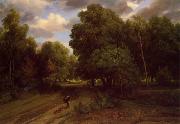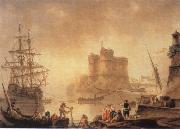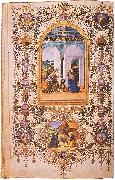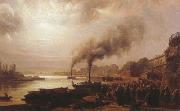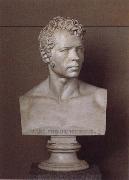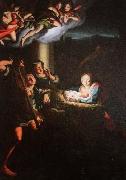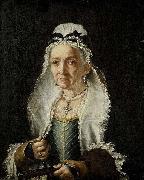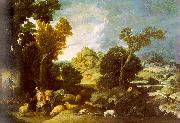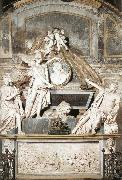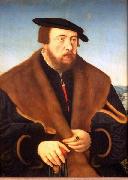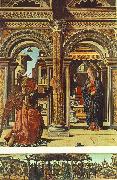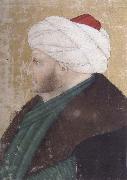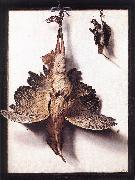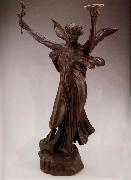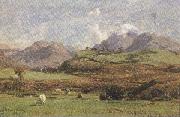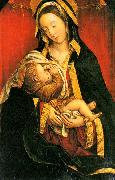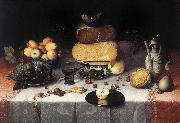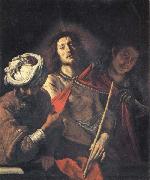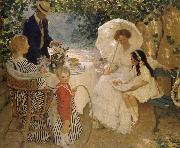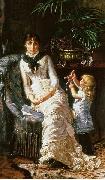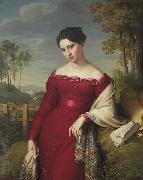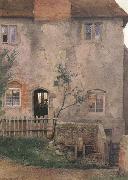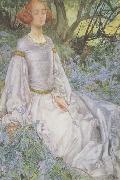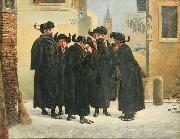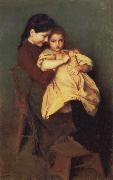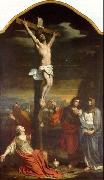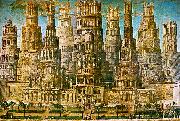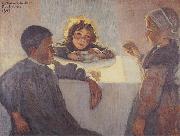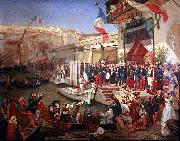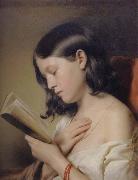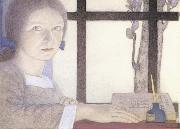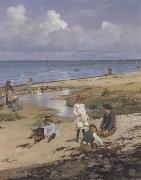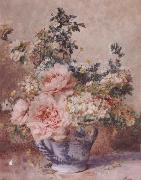|
|
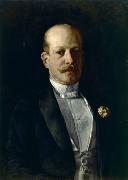 |
Charles Frederic Ulrich
|
|
Charles Frederic Ulrich (1858, New York City - 1908, Berlin), was an American painter.
According to the RKD he worked in the Netherlands ca. 1890. He attended the Royal Academy in Munich, Germany, as did William Merritt Chase, who like him, was influenced by Dutch Golden Age painting and who has been documented as painting his portrait. He was discovered by Thomas B. Clarke, a lace and linen manufacturer in New York who became a collector of contemporary American art. Ulrich painted his portrait in gratitude after his painting "In the Land of Promise, Castle Garden" was shown at the National Academy of Design, where it won the National Academy's first Thomas B. Clarke Prize for Best American Figure Composition. |
|
|
|
 |
Charles Furneaux
|
|
(1835 - 1913) was born in Boston and became a drawing instructor in that area. For many years he lived in the town of Melrose, Massachusetts. In 1880, Furneaux moved to Hawaii, where he cultivated the friendship King Kalakaua and other members of the Hawaiian royal family, from whom he later received several commissions. In the late 1880's,he was commissioned in Honolulu by Alexander Joy Cartwright, widely credited as the "father of baseball" and another dear friend of King Kalakaua, to paint the only oil portrait of his 72 year life. While living in Honolulu he taught at the private schools Punahou and St. Albans (now known as Iolani School). In 1885, he received the order of Chevalier of Kapiolani from King Kalakaua in 'recognition of his services in advancing Hawaiian art'. He died in Hawaii in 1913.
His reputation is mainly based on the paintings he executed in Hawaii, especially those of erupting volcanoes. The Bishop Museum (Honolulu), the Brooklyn Museum, the Honolulu Academy of Arts, Iolani Palace (Honolulu) and Mount Holyoke College Art Museum (South Hadley, Massachusetts) are among the public collections holding works by Charles Furneaux.
|
|
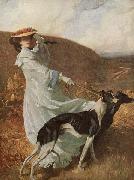 |
Charles Wellington Furse
|
|
(January 13, 1868 - October 16, 1904) was an English painter.
He was born at Staines, the son of the Rev. C. W. Furse, archdeacon of Westminster, and rector of St John's, Smith Square and descended collaterally from Sir Joshua Reynolds; and in his short span of life achieved such rare excellence as a portrait and figure painter that he forms an important link in the chain of British portraiture which extends from the time when Van Dyck was called to the court of Charles I into the 20th century.
His talent was precocious; at the age of seven he gave indications of it in a number of drawings illustrating Scott's novels. He entered the Slade School in 1884, winning the Slade scholarship in the following year, and completed his education at Julians Atelier in Paris. Hard worker as he was, his activity was frequently interrupted by spells of illness, for he had developed signs of consumption when he was still attending the Slade school. An important canvas called Cain was his first contribution (1888) to the Royal Academy, to the associateship of which he was elected in the year of his death. For some years before he had been a staunch supporter of the New English Art Club, to the exhibitions of which he was a regular contributor.
In October 1900 he married Katharine Symonds, the daughter of John Addington Symonds. She later became known as Dame Katharine Furse. The couple had 2 sons. His fondness for sport and of an open-air life found expression in his art and introduced a new, fresh and vigorous note into portraiture. There is never a suggestion of the studio or of the fatiguing pose in his portraits. The sitters appear unconscious of being painted, and are generally seen in the pursuit of their favourite outdoor sport or pastime, in the full enjoyment of life. Such are the Diana of the Uplands, the Lord Roberts and The Return from the Ride at the Tate Gallery; the four children in the Cubbing with the York and Ainsty, The Lilac Gown, Mr. and Mrs. Oliver Fishing and the portraits of Lord Charles Beresford and William Johnson Cory.
Most of these pictures, and indeed nearly all the work completed in the few years of Furse's activity, show a pronounced decorative tendency. His sense of space, composition and decorative design can best be judged by his admirable mural decorations for Liverpool town hall, executed between 1899 and 1902. A memorial exhibition of Furse's paintings and sketches was held at the Burlington Fine Arts Club in 1906.
|
|
|
|
|
|
|
|
|
|
|
|
|
|
|
|
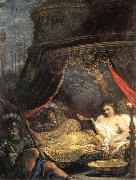 |
Ciro Ferri
|
|
Italian Baroque Era Painter and Sculptor , ca.1634-1689 |
|
|
|
|
|
|
|
|
|
|
|
|
|
|
|
|
|
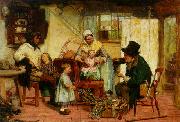 |
David Henry Friston
|
|
(1820 - 1906) was a British illustrator and figure painter in the Victorian Era. He is best remembered as the creator of the first illustrations of Sherlock Holmes in 1887, as well as his illustrations of the controversial female vampire story Carmilla (1872). He is also remembered for his illustrations accompanying reviews of Gilbert and Sullivan operas and plays of W. S. Gilbert in The Illustrated London News and the Illustrated Sporting and Dramatic News in the 1870s and 1880s.
|
|
|
|
 |
Defendente Ferrari
|
|
(c. 1480/1485 - c. 1540) was an Italian painter active in Piedmont.
Ferrari was born at Chivasso, near Turin, and worked in the workshop of Giovanni Martino Spanzotti.
He met considerable success as a painter of polyptychs and altarpieces, characterized by a highly decorative style inspired by Northern Europe masters.
|
|
|
|
|
|
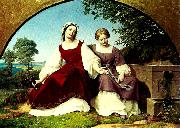 |
e. j. f. bendemann
|
|
Eduard Julius Friedrich Bendemann (3 December 1811, Berlin - 27 December 1889, Dusseldorf) was a German painter.
Bendemann was born in Berlin. His father, Anton Heinrich Bendemann, a Jewish banker, monitored his education closely; it was one that would have naturally led him to some sort of technical occupation, but his talent and propensity towards art resulted in his being allowed to pursue other interests. His mother Fanny Eleonore Bendemann nee von Halle, also a daughter of the Jewish banker Joel Samuel von Halle.
After he completed elementary school he enrolled in the Wilhelm von Schadow's School in Dusseldorf. In 1830 he went on a school trip to Italy. After a series of jobs, among them with Boas and Ruth, his talent as an artist began to show, especially with his very large 1832 painting titled, The Sad Jews of Babylon which was featured in the Berlin art exhibition. The picture garnered a great deal of attention, which was in part due to the deep and simple feeling and the noble composition of the piece (museum in Cologne). Bendemanns second picture: The Two Girls at the Well (1832), was acquired by the North Rhine-Westphalia art association.
Soon thereafter followed Jeremias on the Ruins of Jerusalem for which the artist received a medal in Paris in 1837. This painting was for the most part about the progress of the Jews in Babylon. (Royal Palace in Hanover). His best known work is The Harvest.
The artist's first fresco was a symbolic representation of the art at the Poetry Well at the house of his parents-in-law in Berlin. In the year 1838 he was appointed professor of the academy of arts in Dresden, where he had the opportunity to paint even larger frescos. Bendemann was given the task to decorate three halls of the Dresden royal palace, the throne room, the tower room, and the tower hall with wall paintings. In the throne room, on both sides of the throne, there are representations of important rulers and legislators in gold leaf with smaller representations in relief form below, from Moses up to Albrecht III, the King at the time. On the wall facing the throne there are four paintings depicting events from the life of King Heinrich I each with other pictures attached which explain each of the four events. Bendemann died in Dusseldorf. |
|
|
|
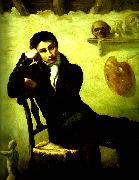 |
ecole francaise
|
|
Founded in 1846, the EfA is the oldest foreign institute in Athens. Its early foundation, still a source of considerable prestige, is to be seen culturally connected with French philhellenism and politically with the French East Mediterranean strategy of the time.
|
|
|
|
|
|
|
|
|
|
|
|
|
|
|
|
|
|
|
|
|
|
|
|
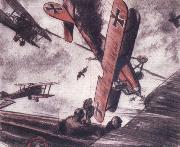 |
Ernest Fuhr
|
|
A popular illustrator of the period and this is classic patriotic art . 1874-1933
|
|
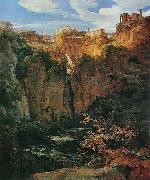 |
Ernst Fries
|
|
(22 June 1801 Heidelberg - 11 October 1833 Karlsruhe) was a German painter.
Fries was a pupil of Karl Kuntz at Karlsruhe, and afterwards studied in Munich and in Italy. Examples of his work are: eA View of Tivoli, Sorrento and the House of Tasso, The Waterfall of Liris at Isola di Sora, The Castle of Massa, and A View of Heidelberg.
|
|
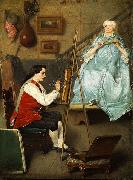 |
Eugene Fichel
|
|
(30 August 1826 Paris - 2 February 1895 Paris) was a French painter.
He entered the École des Beaux-Arts in 1844 and became a pupil of Hippolyte Delaroche, but painted very much more under the inspiration of Jean-Louis-Ernest Meissonier, whose exquisite handling is suggested in numerous small canvases of his which by their refined technique and vivid action recall the characteristic intensity and directness of composition which belong to the painter of eFriedland.e Along with great care in finish, Fichel's canvases also exhibit an archæological exactness, and a kind of delicate humor. His first work of importance was exhibited in 1850, eHarvey Demonstrating the Circulation of the Blood to Charles I.e He was a chevalier of the Legion of Honor and, in 1857, received a medal for his painting in the Salon of that year. He exhibited a canvas every year at the Salon, up to a few years before his death.
|
|
|
|
|
|
|
|
|
|
|
|
|
|
|
|
|
|











